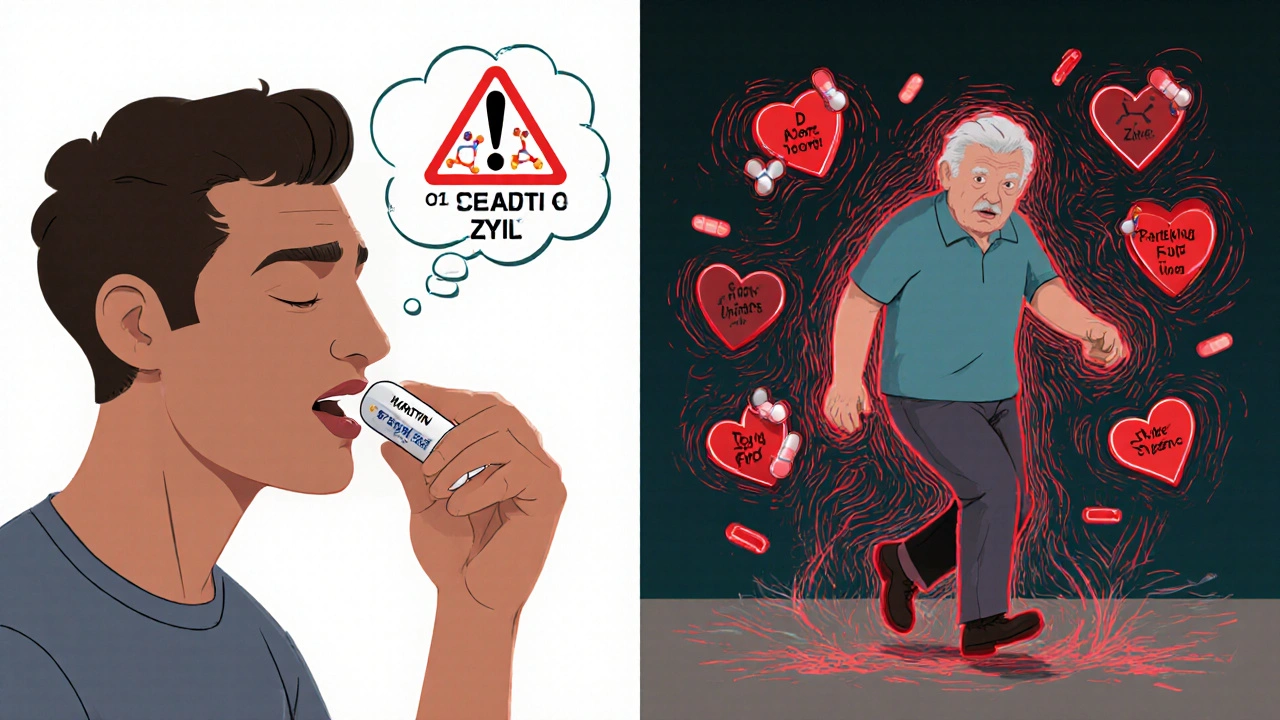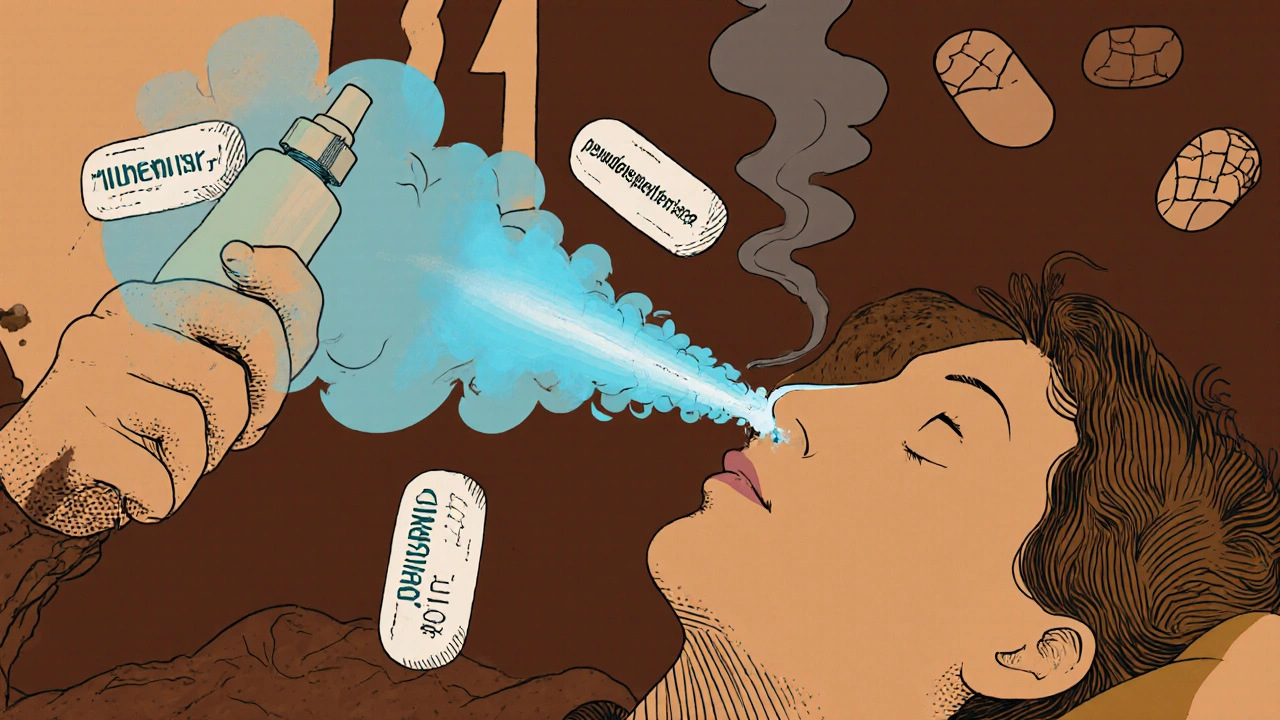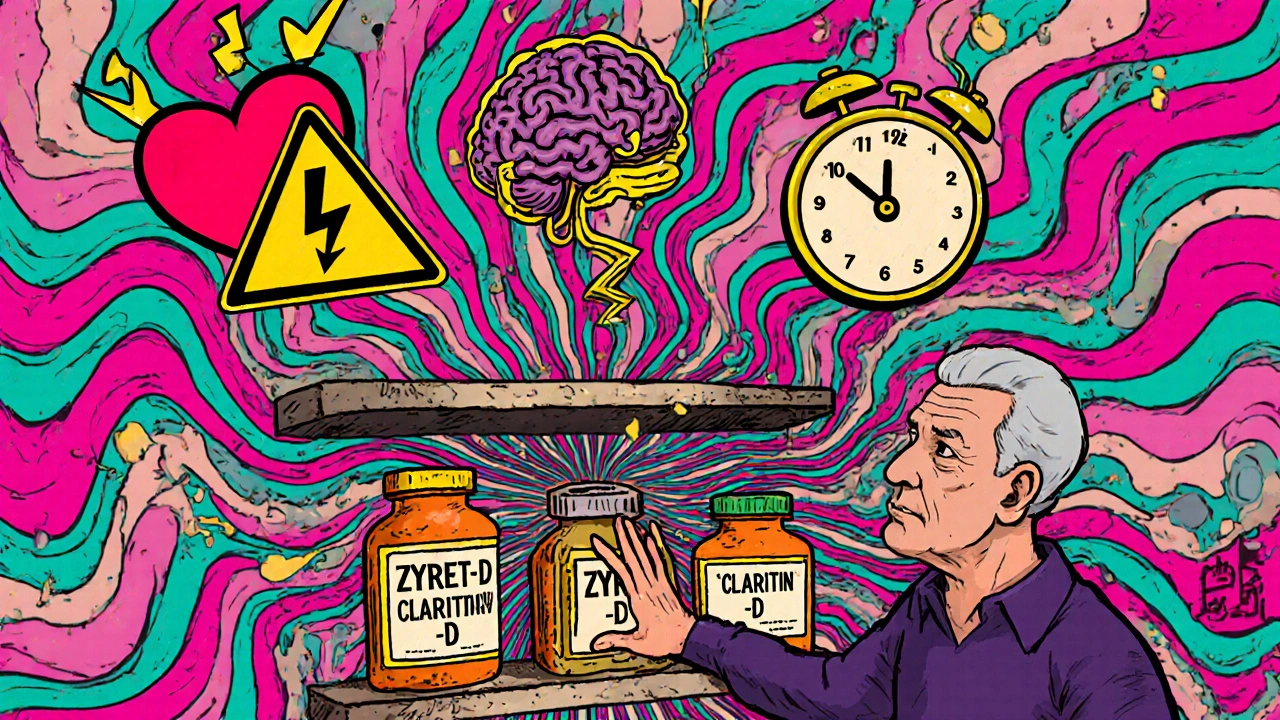Medication Safety Checker
Check for Duplicate Medications
Enter medications you're taking to see if you're accidentally combining duplicate ingredients or potentially dangerous combinations.
Many people reach for combination cold and allergy meds without thinking twice. Products like Zyrtec-D, Claritin-D, and Allegra-D promise quick relief from runny noses, sneezing, and congestion-all in one pill. But behind that convenience lies a real risk. These medications mix a decongestant like pseudoephedrine with an antihistamine like cetirizine or loratadine. Sounds simple, right? It’s not. The combination can cause serious side effects, especially if you don’t know what you’re taking or have underlying health issues.
How These Medications Actually Work
Decongestants shrink swollen blood vessels in your nose. That’s why your stuffy nose clears up. But they don’t just target your nasal passages. They tighten blood vessels everywhere, including in your heart and brain. This can raise your blood pressure, speed up your heart rate, and make you feel jittery or anxious. Pseudoephedrine, the most common decongestant in these combos, increases systolic blood pressure by 5-10 mmHg in people with high blood pressure. That’s not a small bump-it’s enough to trigger chest pain or even a stroke in vulnerable people.
Antihistamines block histamine, the chemical your body releases during allergies. First-gen ones like diphenhydramine (Benadryl) make you sleepy-about half of users feel drowsy. Second-gen ones like cetirizine (Zyrtec) and loratadine (Claritin) are less sedating, but they still cause drowsiness in up to 14% of people. That’s not rare. That’s one in seven. And if you’re already tired, driving, or operating machinery, that’s dangerous.
The Real Danger: Overlapping Doses
Most people don’t realize they’re doubling up. You take Claritin-D for your allergies. Later, you grab a cold medicine that says “for sinus and allergy relief.” It also contains loratadine. Now you’ve taken two doses of the same antihistamine. Same thing with Benadryl and Zyrtec. Both are antihistamines. Taking them together? That’s a recipe for overdose.
Poison Control says it plainly: “Do NOT take two different antihistamines at the same time.” Symptoms of an antihistamine overdose include dry mouth, fast heartbeat, agitation, confusion, blurred vision, and poor coordination. In severe cases, it can lead to seizures, cardiac arrest, or death. A 2022 review of adverse event reports found that over 1,800 people in the U.S. had serious reactions to these combination drugs-just in one year.
Who’s at Highest Risk?
These meds aren’t safe for everyone. If you have any of these conditions, you should avoid them altogether:
- High blood pressure
- Heart disease or irregular heartbeat
- Diabetes
- Thyroid problems
- Enlarged prostate
- Glaucoma
Older adults are especially vulnerable. Their bodies process drugs slower. A dose that’s fine for a 30-year-old can overwhelm a 70-year-old. Harvard Health warns that seniors are more sensitive to the sedating effects and blood pressure spikes. One study showed that 30% of older adults using these combos experienced dizziness or falls-leading to hospital visits.
Children under 12 shouldn’t take them either. The American College of Allergy, Asthma, and Immunology says there’s no solid proof they work in kids, but plenty of evidence they cause harm-agitation, rapid heartbeat, and even hallucinations.

What the Studies Say
It’s easy to assume that because these drugs are sold over the counter, they’re harmless. But research tells a different story. A Cochrane review of 13 clinical trials found that while these combinations might offer slight symptom relief in adults, the benefits are small-and the side effects are common. Nearly 1 in 5 people taking them had adverse reactions, compared to 1 in 8 taking a placebo. That’s a 58% higher chance of something going wrong.
And it’s not just drowsiness. The most frequent complaints were dry mouth, constipation, nausea, dizziness, and trouble sleeping. In some cases, people reported chest pain or palpitations. The FDA pulled phenylpropanolamine-a once-common decongestant-from the market in 2005 after it was linked to strokes in young women. That’s why today’s products use pseudoephedrine instead. But pseudoephedrine isn’t risk-free. It’s still a stimulant. It still raises blood pressure. It still affects your heart.
What to Do Instead
You don’t need a combo pill to feel better. Here’s what works better-and safer:
- Use a saline nasal spray to flush out mucus and allergens. No side effects.
- Try a standalone antihistamine if you have sneezing or itching. Pick one: Zyrtec, Claritin, or Allegra. Take it once a day. Don’t add another.
- If congestion is your main issue, use a nasal decongestant spray like oxymetazoline-but only for 3 days max. Longer use makes congestion worse.
- For pain or fever, use plain acetaminophen or ibuprofen. Don’t pick a combo that adds it in.
Ask your pharmacist to check your meds. They can spot hidden duplicates. Many people don’t realize that cold, flu, and allergy products all contain the same active ingredients under different names. A quick check can prevent a dangerous mix-up.

When to Call a Doctor
If you’ve taken one of these combos and feel any of these, get help immediately:
- Rapid or pounding heartbeat
- Chest pain or pressure
- Severe dizziness or fainting
- Difficulty breathing
- Confusion or hallucinations
- Seizures
These aren’t normal side effects. They’re warning signs. Don’t wait. Call Poison Control at 1-800-222-1222 or go to the ER.
Bottom Line
Combination decongestant-antihistamine pills aren’t the magic solution they’re sold as. They’re a gamble. For some people, they work. For many others, they cause more problems than they fix. If you have high blood pressure, heart trouble, are over 65, or are giving meds to a child, skip them. Use targeted, single-ingredient treatments instead. Read the labels. Know what’s in each pill. And never mix antihistamines. Your heart and brain will thank you.
Can I take Zyrtec and Claritin together?
No. Both Zyrtec (cetirizine) and Claritin (loratadine) are second-generation antihistamines. Taking them together doesn’t make relief better-it doubles your risk of side effects like drowsiness, dry mouth, and dizziness. Stick to one antihistamine at a time. If one doesn’t work, talk to your doctor about switching, not stacking.
Is pseudoephedrine safer than phenylephrine?
Pseudoephedrine is more effective as a decongestant, which is why it’s used in products like Claritin-D and Zyrtec-D. Phenylephrine, found in many store-brand versions, has been shown in multiple studies to have little to no effect on nasal congestion. But pseudoephedrine carries higher risks for people with high blood pressure or heart conditions. Neither is risk-free. If you have cardiovascular issues, avoid both.
Can I take a decongestant-antihistamine combo if I’m on blood pressure medication?
Not without talking to your doctor first. Decongestants like pseudoephedrine can interfere with blood pressure meds, causing your pressure to spike. Even if your pressure is controlled now, the combo can undo that. Many people don’t realize their meds are interacting until they feel dizzy or get chest pain. Always check with your pharmacist or doctor before adding any OTC product to your routine.
How long does it take for antihistamines to leave your system?
Second-gen antihistamines like Zyrtec and Claritin last about 24 hours. First-gen ones like Benadryl wear off in 4-6 hours but can linger in older adults or people with kidney problems. If you take Benadryl at night and Zyrtec the next morning, you’re still getting overlapping doses. Wait at least 24 hours between different antihistamines, and never combine them unless a doctor tells you to.
Are there natural alternatives to decongestant-antihistamine combos?
Yes. Saline nasal rinses, humidifiers, and staying hydrated can reduce congestion without drugs. For allergies, reducing exposure to triggers-like dust mites, pet dander, or pollen-is more effective long-term than pills. Some people find relief with quercetin (a natural plant compound) or butterbur extract, though evidence is limited. Always talk to your doctor before trying supplements, especially if you’re on other meds.


Anthony Griek
October 30, 2025 AT 04:30I used to grab those combo pills like candy until I started getting heart palpitations after work. Turns out I had undiagnosed high blood pressure. My pharmacist caught it when I asked about Zyrtec-D. Now I just use saline spray and a single antihistamine. No more surprises. Simple works better.
Norman Rexford
November 1, 2025 AT 03:41bro why are we even talking about this like its rocket science?? its just a cold dude. if you wanna feel better take the pill. if your heart starts racing then maybe dont take it again. stop overthinking everything. america is falling apart because people read labels instead of living.
Wayne Keller
November 2, 2025 AT 12:06Good post. Really clear breakdown. I work in retail and see people buying these combos every day without knowing what’s in them. The worst part? They’ll take two different brands thinking one’s for allergies and one’s for colds. They’re literally the same chemicals. Always check the active ingredients - it’s not hard. Just look for ‘cetirizine’, ‘loratadine’, ‘pseudoephedrine’. If you see it twice, don’t take both.
Also - if you’re over 60, just skip the decongestant entirely. Saline rinses and a humidifier do more than half the combo pills ever did.
Shana Labed
November 2, 2025 AT 15:04OMG YES!! I had a panic attack last winter because I took Claritin-D and then a NyQuil later because I ‘thought’ it was just for sleep 😭 I felt like my chest was being squeezed by a dragon and my tongue went numb. Called poison control at 2am and they were like ‘you idiot, you doubled up on loratadine’. I cried. I’m now a label-reading ninja. 🧠💊
California Daughter
November 3, 2025 AT 11:37Vishwajeet Gade
November 4, 2025 AT 10:32Casey Crowell
November 5, 2025 AT 06:17THIS. So many people don’t realize how dangerous these combos are. I’m a nurse and I’ve seen three ER visits in the last month from people taking Zyrtec-D + DayQuil. 💔 It’s not just drowsiness - it’s cardiac stress, confusion, even seizures. Please, if you’re on any meds, even blood pressure, ask your pharmacist before touching anything labeled ‘sinus’ or ‘allergy’. Seriously. One quick check saves lives. ❤️🩺
Shanna Talley
November 7, 2025 AT 02:59Reading this made me feel so much better about finally ditching those combo pills. I used to take them every fall like clockwork. Then I started feeling foggy all day and my BP spiked. My doctor said, ‘You don’t need all that. Just pick one thing.’ I picked Claritin and a nasal rinse. I feel clearer than I have in years. Sometimes the simplest choices are the most powerful.
Samuel Wood
November 8, 2025 AT 14:59While your piece is superficially informative, one must interrogate the epistemological foundations of OTC pharmacology in late-stage capitalism. The very notion that ‘safety’ can be commodified via pharmaceutical labeling is a Hegelian inversion of medical autonomy. Pseudoephedrine is merely a symptom - the disease is the neoliberal erasure of holistic care. And yet… you still recommend saline sprays? How quaint.